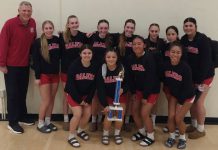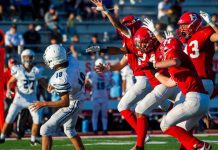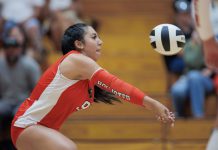Pitching instructor picked up by the Mets to scout high school
players
Rich Taylor knows talent when he sees it. So much so that the
New York Mets recently hired the 49-year-old pitching instructor
from Morgan Hill to scout high school ball players from south San
Jose all the way to Salinas.
Taylor, who also owns and operates the California Pitching
Academy in Morgan Hill, was offered the job with the Mets
organization three weeks ago after meeting with the club’s regional
scouting supervisor, who had contacted Taylor after seeing him give
a pitching clinic at the Dusty Baker baseball camp in
Sacramento.
Pitching instructor picked up by the Mets to scout high school players
Rich Taylor knows talent when he sees it. So much so that the New York Mets recently hired the 49-year-old pitching instructor from Morgan Hill to scout high school ball players from south San Jose all the way to Salinas.
Taylor, who also owns and operates the California Pitching Academy in Morgan Hill, was offered the job with the Mets organization three weeks ago after meeting with the club’s regional scouting supervisor, who had contacted Taylor after seeing him give a pitching clinic at the Dusty Baker baseball camp in Sacramento.
For Taylor, a former minor league pitcher and Major League scout with the Chicago White Sox in the late 1980s, the opportunity to get back into professional baseball was welcomed news.
Despite his new scouting demands, Taylor expects it to be business as usual at his pitching facility in Morgan Hill.
Recently The Pinnacle had a chance to talk with Taylor about his new position on everything from what he looks for in a Major League prospect to how many Baler games he plans on attending next season.
Q: What players will you be looking at as an area scout for the Mets?
A: I’ll be scouting mainly high school players in the San Jose, Monterey and Salinas regions.
Q: I guess that means you’ll be going to a lot of games?
A: I’ll probably see between six and 12 a week. A lot of it is keeping track of the local high school players, going to games and getting to know the coaches. I also get information from reading local papers and periodicals about the players. A lot of it is word of mouth and developing a good rapport with the high school coaches. A lot of times we go to watch a specific kid because someone has told us about him. I’ll be scouting every position, not just pitching.
Q: Do you think you’ll be at many San Benito High baseball games?
A: As many as I need to be at until I’ve made a decision whether the player is a pro prospect or not. I could go to one game there or it could be six games. I never make a decision after seeing a player just one time. I’ll also give kids another chance if they have a bad day. You might see a good hitter go 0-for-4 or a pitcher struggle, but that doesn’t mean they are bad.
Q: What types of things are you looking for?
A: If it’s a pitcher, I’m looking at arm action No. 1, velocity and his build and makeup. What type of command does he have over the pitches that he throws?
Q: I remember going to a San Benito High baseball game a few years back and three scouts were in the stands to watch Live Oak pitcher Ryan Muller. They were all there to see Muller and one of the players for San Benito was even more impressive that afternoon. Did that ever happen to you when you were a scout before?
A: That happens once in a while. You go to a game to see someone and someone else catches your eye.
Q: Are you only looking at 18-year olds?
A: Pretty much. I’ll go to some junior college games too. Sometimes someone at the junior college level gets overlooked. We have one scout who handles all of Northern California for that. In a case like that, he might call me and have me go watch someone at Gavilan or something.
Q: How do you single someone out of the pack?
A: There are five major tools that you look at: fielding, throwing, running, hitting, and hitting for power. The God-given stuff is the throwing arm and the running ability. You can learn to hit for power, for example, if you have the tools and body type. Then, we look at those skills and try to project where that player is going to be in a few years.
Q: Since high school is the farthest step from the Majors and these players are still developing and growing, is accurately scouting them hardest?
A: In some respects yes because you’re trying to look at their overall future potential. They might not be ready to play now but they might be in four years.
Q: You say that you look at the five tools. What if there is a left-handed pitcher who can throw 94 mph but can’t field or do anything else? Won’t that kid still get looked at? Isn’t being a lefty with a live arm the fastest track to the Majors?
A: If there was a left-hander who could throw 93 or 94 mph they’d definitely get looked at. We’d also look at the arm action and mechanics. Pitching is thought of as the easiest position to get a look but there are a lot of pitchers out there too, more than there are position players. The fastest track to the big leagues could possibly be at catcher, but don’t hold me to that. A perfect example is Mike Piazza. He went in the 34th round of the draft. He developed and got on the fast track.
Q: What else do you look for?
A: They (Mets) like us to go out and find players that are well liked, good people with good attitudes.
Q: What if a guy has a ton of talent but he has the mind set of a Terrell Owens or someone who has a has a similar troublesome personality?
A: We get to know him long before we ever draft him. We get to know him as a person. We meet his parents and his family and spend time with him.
Q: I’ve often noticed that scouts tend to be real secretive at a game and often don’t even like to say which team they represent. Why is that? Is it really that hush, hush of a business?
A: Me personally, I’d say who I was with but sometimes they don’t like to be bothered because they have a job to do. They don’t want to focus or talk about anything else because they are compensated and trusted by the team they are working for.
Q: Do all of the teams have a scout in this area?
A: No. I’d say if you have 30 teams probably 30 percent of them have a scout in the area. When I was scouting in Southern California for the White Sox every team had a scout down there, sometimes two or three.
Q: So what if there is a kid in South Dakota right now who can throw a 100 mph fastball will he have less opportunity and chance for exposure than the kid in Southern California?
A: No, because the Major League has its own scouting bureau that is everywhere in the country. If they see a kid with talent they will tell the teams themselves to go see him.
Q: Who was the top prospect you scouted when you where with the White Sox?
A: A pitcher named Roger Salkeld. He wound up going to the Mariners in the first round with the fifth overall pick. You know who the White Sox ended up drafting that year? Frank Thomas.
Q: I would imagine that young pitchers will be lining up now to join your pitching academy now that they know you are a scout.
A: A lot of people don’t know yet that I’ll be scouting. It should lend some credibility to the academy. People might take a little more notice.
Q: Do you scout year-round and how anxious are you to get started?
A: I’m going to do this year-round and I’ll be looking forward to it immensely. This is a way for me to get back into pro baseball. Years from now I want to do a lot more at the pro level.










